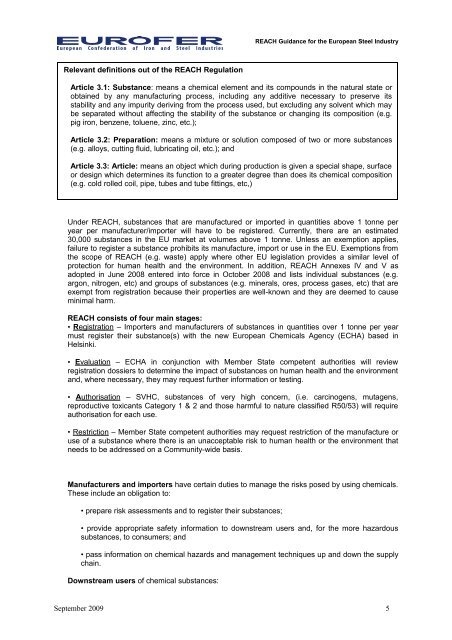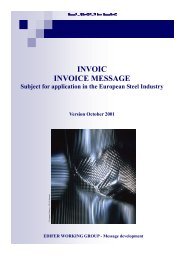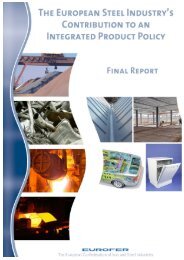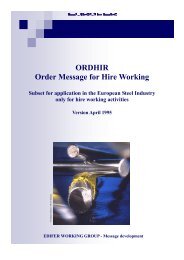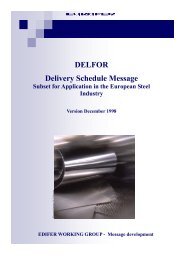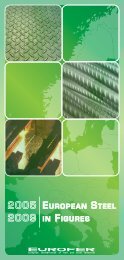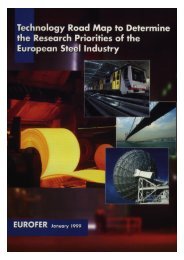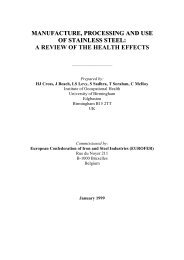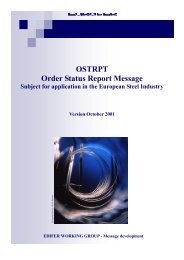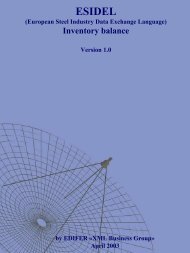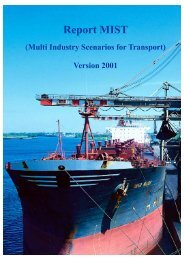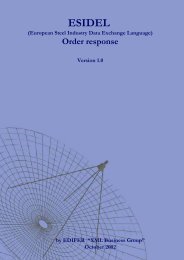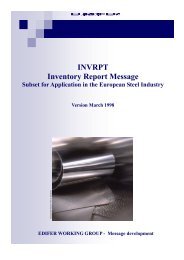EUROFER REACH guidance for the European Steel Industry. 09.09 ...
EUROFER REACH guidance for the European Steel Industry. 09.09 ...
EUROFER REACH guidance for the European Steel Industry. 09.09 ...
Create successful ePaper yourself
Turn your PDF publications into a flip-book with our unique Google optimized e-Paper software.
Relevant definitions out of <strong>the</strong> <strong>REACH</strong> Regulation<br />
<strong>REACH</strong> Guidance <strong>for</strong> <strong>the</strong> <strong>European</strong> <strong>Steel</strong> <strong>Industry</strong><br />
Article 3.1: Substance: means a chemical element and its compounds in <strong>the</strong> natural state or<br />
obtained by any manufacturing process, including any additive necessary to preserve its<br />
stability and any impurity deriving from <strong>the</strong> process used, but excluding any solvent which may<br />
be separated without affecting <strong>the</strong> stability of <strong>the</strong> substance or changing its composition (e.g.<br />
pig iron, benzene, toluene, zinc, etc.);<br />
Article 3.2: Preparation: means a mixture or solution composed of two or more substances<br />
(e.g. alloys, cutting fluid, lubricating oil, etc.); and<br />
Article 3.3: Article: means an object which during production is given a special shape, surface<br />
or design which determines its function to a greater degree than does its chemical composition<br />
(e.g. cold rolled coil, pipe, tubes and tube fittings, etc,)<br />
Under <strong>REACH</strong>, substances that are manufactured or imported in quantities above 1 tonne per<br />
year per manufacturer/importer will have to be registered. Currently, <strong>the</strong>re are an estimated<br />
30,000 substances in <strong>the</strong> EU market at volumes above 1 tonne. Unless an exemption applies,<br />
failure to register a substance prohibits its manufacture, import or use in <strong>the</strong> EU. Exemptions from<br />
<strong>the</strong> scope of <strong>REACH</strong> (e.g. waste) apply where o<strong>the</strong>r EU legislation provides a similar level of<br />
protection <strong>for</strong> human health and <strong>the</strong> environment. In addition, <strong>REACH</strong> Annexes IV and V as<br />
adopted in June 2008 entered into <strong>for</strong>ce in October 2008 and lists individual substances (e.g.<br />
argon, nitrogen, etc) and groups of substances (e.g. minerals, ores, process gases, etc) that are<br />
exempt from registration because <strong>the</strong>ir properties are well-known and <strong>the</strong>y are deemed to cause<br />
minimal harm.<br />
<strong>REACH</strong> consists of four main stages:<br />
• R egistration – Importers and manufacturers of substances in quantities over 1 tonne per year<br />
must register <strong>the</strong>ir substance(s) with <strong>the</strong> new <strong>European</strong> Chemicals Agency (ECHA) based in<br />
Helsinki.<br />
• E valuation – ECHA in conjunction with Member State competent authorities will review<br />
registration dossiers to determine <strong>the</strong> impact of substances on human health and <strong>the</strong> environment<br />
and, where necessary, <strong>the</strong>y may request fur<strong>the</strong>r in<strong>for</strong>mation or testing.<br />
• A uthorisation – SVHC, substances of very high concern, (i.e. carcinogens, mutagens,<br />
reproductive toxicants Category 1 & 2 and those harmful to nature classified R50/53) will require<br />
authorisation <strong>for</strong> each use.<br />
• Restriction – Member State competent authorities may request restriction of <strong>the</strong> manufacture or<br />
use of a substance where <strong>the</strong>re is an unacceptable risk to human health or <strong>the</strong> environment that<br />
needs to be addressed on a Community-wide basis.<br />
Manufacturers and importers have certain duties to manage <strong>the</strong> risks posed by using chemicals.<br />
These include an obligation to:<br />
• prepare risk assessments and to register <strong>the</strong>ir substances;<br />
• provide appropriate safety in<strong>for</strong>mation to downstream users and, <strong>for</strong> <strong>the</strong> more hazardous<br />
substances, to consumers; and<br />
• pass in<strong>for</strong>mation on chemical hazards and management techniques up and down <strong>the</strong> supply<br />
chain.<br />
Downstream users of chemical substances:<br />
September 2009 5


